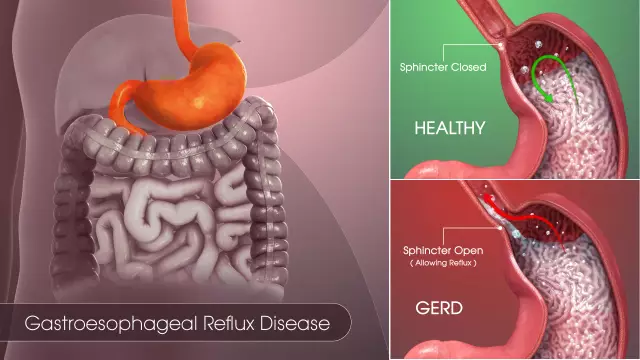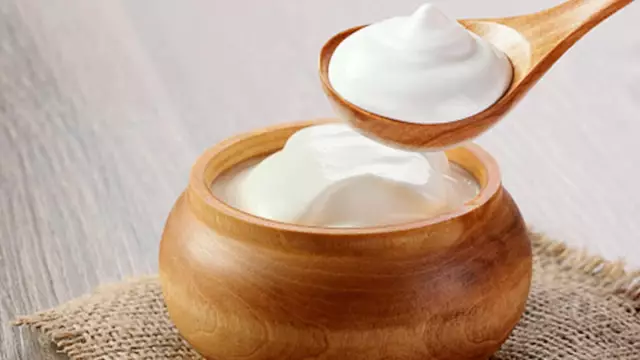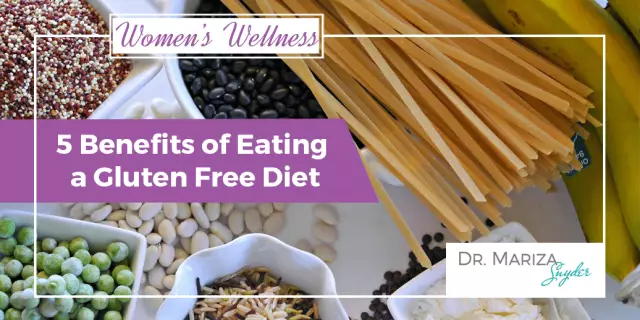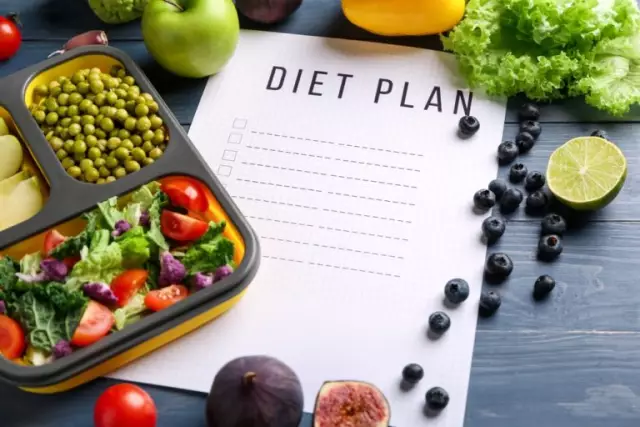- Author Rachel Wainwright [email protected].
- Public 2023-12-15 07:39.
- Last modified 2025-11-02 20:14.
Reflux esophagitis

Reflux esophagitis is a chronic disease, which consists in the pathological reflux of gastric contents into the esophagus. Since the mucous membrane does not have protection against such aggressive substances, due to contact with them, epithelial damage occurs with further inflammation and, accordingly, painful sensations.
Reflux Esophagitis Causes
The main cause of reflux esophagitis is a malfunction or decreased muscle tone of the esophageal sphincter. Because of this, it constantly remains fully or partially open, which allows gastric contents to freely enter it. This disorder can occur due to nervous overload, increased abdominal pressure, or food and chemical factors.
The second cause of reflux esophagitis is a hernia in the alimentary opening of the diaphragm. Through this expansion (hernia) during increased pressure in the abdominal cavity (for example, when lifting weights), half of the stomach with its contents is able to penetrate into the chest cavity.
Reflux esophagitis can also occur due to:
- Surgical interventions on the alimentary opening in or near the diaphragm (with vagotomy, resection of the cardiac gastric section, esophagogastrostomy, gastric resection, castrectomy);
- Helicobacter pylori-associated gastritis;
- Insufficiency of the sphincter during obesity;
- Medicines that can lower the tone in the lower esophageal sphincter;
- Pregnancy;
- Drinking alcohol;
- Smoking;
- Scleroderma;
- Pylorospasm or pyloroduodenal stenosis;
- Peptic ulcer of the duodenum and stomach.
Reflux esophagitis symptoms
Reflux esophagitis symptoms can appear as:
- Heartburn. Heartburn is the most common symptom of reflux esophagitis (observed in 83% of patients). Heartburn is caused by prolonged contact of stomach acid with the mucous membrane in the esophagus. Non-dieting, bending over, lying down, drinking alcohol, soda, and physical exertion can worsen heartburn.
- Belching that is worse after eating or soda.
- Regurgitation of food, which is worse during exercise.
- Swallowing disorders.
- Pain in the chest or in the epigastric region. These pains can occur a short time after eating, intensify during bending and in horizontal positions.
- Sensation of a lump in the throat during swallowing and pain in the lower jaw and in the ear. These reflux esophagitis symptoms occur much less frequently than the above symptoms.
Erosive reflux esophagitis
Erosive reflux esophagitis is very deeply affecting the lining of the esophagus. With this type of esophagitis, ulcers and erosion are formed on the mucous wall of the esophagus. Erosive reflux esophagitis has several stages:
- The first stage is characterized by the formation of small single erosions in the lower section;
- During the second stage, the affected area gradually increases up to one third of the esophagus;
- The third stage is characterized by the formation of a chronic ulcer in the esophagus.
The situation with erosive reflux esophagitis may worsen due to the use of foods with high acidity (citrus fruits, lactic acid products and sour juices), caffeine, smoking, alcohol and some drugs (non-steroidal anti-inflammatory drugs: aspirin, paracetamol, analgin).
If erosive reflux esophagitis is not treated for a long time, you can get serious complications: bleeding (vomiting of scarlet blood or "coffee grounds"), scars on the walls of the mucous membrane, due to which the esophagus can narrow (stenosis).
Catarrhal reflux esophagitis

With catarrhal reflux esophagitis, the upper layer of the esophageal mucosa is affected. During endoscopic examination, this is revealed in the form of edema and hyperemia of the esophageal mucosa.
Catarrhal reflux esophagitis is characterized by pain along the entire length of the esophagus and in the place of its transition to the stomach, feelings of rawness in the chest, dysphagia. These symptoms appear while eating or immediately after eating. Heartburn, air belching, and regurgitation may also occur.
Reflux Esophagitis Treatment
The treatment of reflux esophagitis should be approached in an integrated manner: take medication and follow a diet.
When treating reflux esophagitis, you must:
- stop smoking;
- normalize body weight;
- raise the head end of the bed;
- do not load the abdominal muscles, do not work in an inclined position, do not wear tight belts or belts;
- exclude the use of drugs that tend to lower the tone of the esophageal sphincter (antidepressants, progesterone, theophylline, calcium antagonists, nitrates).
Diet for reflux esophagitis
Diet for reflux esophagitis consists of:
- avoiding overeating, you should also eat food no later than three or four hours before bedtime;
- avoiding foods that can reduce the tone of the lower esophageal sphincter (chocolate, coffee, pepper, garlic, onions);
- avoiding very cold or very hot, spicy foods;
- limiting yourself in foods that increase gassing.
YouTube video related to the article:
The information is generalized and provided for informational purposes only. At the first sign of illness, see your doctor. Self-medication is hazardous to health!






